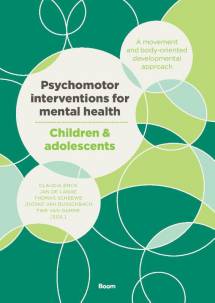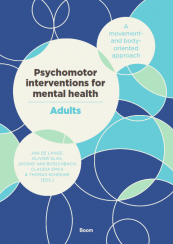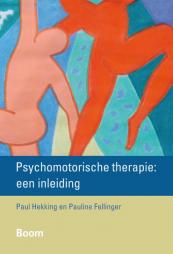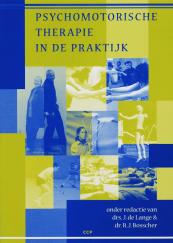Psychomotor interventions for mental health – Children & adolescents
A movement- and body-oriented developmental approach
Psychomotorische interventies voor kinderen en adolescenten
In dit tweede handboek Psychomotor interventions for mental health, als aanvulling op het eerste boek over volwassenen, beschrijven vooraanstaande onderzoekers en clinici de state-of-the-art met betrekking tot psychomotorische interventies voor kinderen, adolescenten en personen met een verstandelijke beperking. Vanuit een transdiagnostisch, belichaamd ontwikkelingsperspectief worden de behandelingen van kinderen en adolescenten met psychische gezondheidsproblemen en/of neurologische ontwikkelingsproblemen besproken, evenals interventies voor personen met een verstandelijke beperking.
Aanvulling op (psycho)therapie en farmacologische behandeling
De benadering komt voort uit de Nederlandse en Vlaamse traditie van psychomotorische therapie, maar weerspiegelt de groeiende interesse van professionals in de geestelijke gezondheidszorg voor bewegings- en lichaamsgerichte methoden als aanvulling op, of alternatief voor, primair verbale vormen van (psycho)therapie en farmacologische behandelingen. Bovendien omarmt het de recente inzichten over het belang van het bevorderen van een actieve levensstijl en het verhogen van fysieke activiteit bij personen met psychische problemen.
Bewegings- en lichaamsgerichte interventies
Psychomotor interventions for mental health biedt belangrijke en actuele informatie voor professionals in de geestelijke gezondheidszorg en onderzoekers die geïnteresseerd zijn in het gebruik van psychomotorische interventies binnen de ggz en actuele ontwikkelingen op het bredere gebied van bewegings- en lichaamsgerichte interventies.
English description of Psychomotor interventions for mental health
In this second handbook, as an addition to the first book focusing on adults, leading researchers and clinicians describe the state-of-the-art regarding psychomotor interventions for children, adolescents and individuals with intellectual disabilities. Starting from a transdiagnostic, embodied, developmental perspective, the treatments of children and adolescents with mental health and/or neurodevelopmental problems, as well as interventions for individuals with an intellectual disability are discussed.
The outlined approach stems from the Dutch and Flemish tradition of psychomotor therapy, yet it reflects the growing interest of mental health professionals in movement- and body-oriented methods as complementary or alternative to primarily verbal forms of (psycho)therapy and pharmacological treatments. Moreover, it embraces the recent insights regarding the importance of promoting an active lifestyle and increasing physical activity in individuals with mental health problems.
This handbook provides key and up-to-date information for mental health professionals and researchers who are interested in the use of psychomotor interventions within mental health care as well as current developments in the broader field of movement-and body-oriented interventions.
Preface
1 Problems and disorders in (early) development: a psychomotor approach
1.1 Psychomotor interventions and (neuro)developmental problems
1.2 Theoretical basis
1.3 Psychomotor assessment
1.4 Psychomotor interventions as a transdiagnostic, embodied, developmental approach
References
2 Psychomotor therapy in individuals with mild intellectual disabilities or borderline intellectual functioning
2.1 Introduction
2.2 Movement behaviour and bodily experience
2.3 Treatment
2.4 Theoretical background
2.5 Conclusion
References
Appendix 1 (Table A1): Overview of the Dutch PMT products used to treat individuals with MID-BIF
3 Psychomotor child therapy for children with attachment disorders
3.1 General characteristics and psychopathology
3.2 PMCT assessment
3.3 General and PMCT-specific goals
3.4 Treatment
3.5 Psychomotor intervention
3.6 Conclusion
References
4 Psychomotor interventions for children and adolescents with developmental coordination disorder
4.1 Comorbidity and risk factors
4.2 Assessment and diagnostic procedures
4.3 Theoretical models: from research to clinical practice
4.4 Intervention
4.5 Conclusion
References
5 Psychomotor interventions for children and adolescents with autism spectrum disorders
5.1 Introduction
5.2 Movement behaviour and body experience
5.3 Neuropsychology and embodiment
5.4 General guidelines and treatment models
5.5 Movement- and body-oriented interventions and their evidence base
5.6 Conclusion
Acknowledgements
References
6 Psychomotor interventions for children and adolescents with attention deficit hyperactivity disorder
6.1 Movement behaviour and bodily experience
6.2 Aetiology and underlying features of children with ADHD relevant to PMT
6.3 Genetics
6.4 Neurological factors
6.5 Environment
6.6 Child characteristics
6.7 Treatment: psychosocial interventions and psychomotor practice
6.8 Interventions from a systemic approach
6.9 Psychomotor interventions based on (cognitive) behavioural therapy
6.10 Physical activity and exercise-based interventions
6.11 Self-esteem, social relations and group PMT
6.12 Therapeutic attitude in psychomotor practice
6.13 Conclusion
References
7 Psychomotor interventions for children and adolescents with anxiety disorders
7.1 Psychopathology
7.2 Movement behaviour and body experience
7.3 Treatment
7.4 Conclusions
References
8 Psychomotor therapy for children and young people with developmental trauma
8.1 General characteristics and psychopathology
8.2 Developmental trauma
8.3 Theoretical background
8.4 Psychomotor interventions
8.5 Conclusion
Acknowledgements
References
9 Psychomotor therapy for adolescents with anorexia nervosa
9.1 General characteristics
9.2 Characteristics of adolescents with anorexia nervosa
9.3 Assessment
9.4 Treatment
9.5 Emotion dysregulation
9.6 Psychosocial dysfunction
9.7 Negative self-image
9.8 Additional psychomotor interventions for adolescents with anorexia nervosa
9.9 Attention focus and attitude of the psychomotor therapist
9.10 Treatment planning and phases
9.11 Conclusion
References
10 Psychomotor interventions for children and youth at ultra-high risk for developing psychosis
10.1 General introduction
10.2 Psychopathology
10.3 Movement behavior
10.4 Bodily experience
10.5 Social behaviour
10.6 Stress
10.7 Psychomotor assessment
10.8 Treatment
10.9 Psychomotor interventions
10.10 Conclusion
10.11 Future research and development
References
11 Psychomotor family therapy: a system-oriented approach
11.1 General characteristics/psychopathology
11.2 The relevance of family therapy
11.3 Treatment
11.4 Psychomotor interventions
11.5 Conclusion
References
Index
Authors







